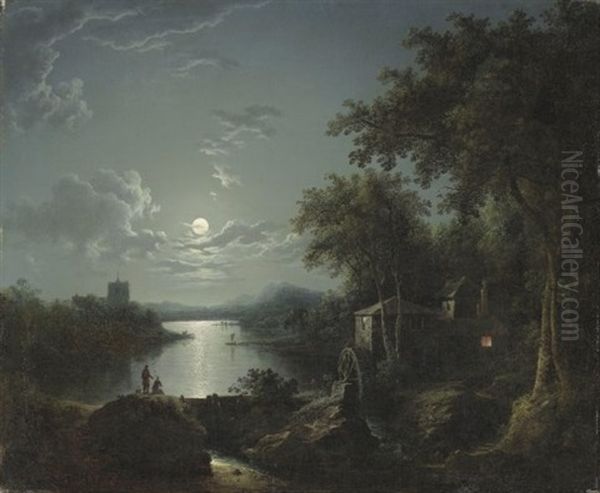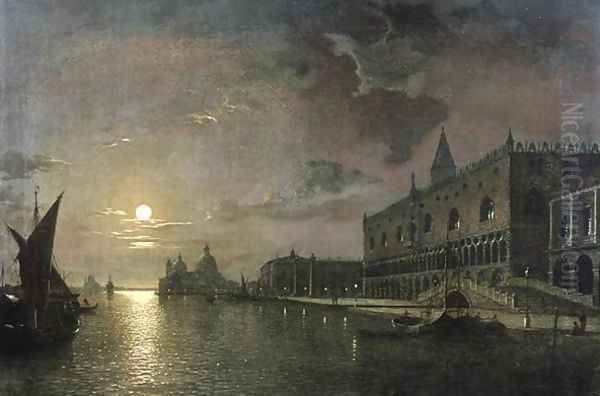Henry Pether stands as a significant, albeit sometimes overlooked, figure in the landscape of 19th-century British art. Active during the mid-Victorian era, Pether carved a distinct niche for himself as a painter of landscapes, particularly renowned for his evocative and atmospheric depictions of moonlit scenes. Working within a period rich with artistic exploration and diversification, Pether focused his talents on capturing the subtle interplay of light and shadow, transforming familiar locations into realms of quiet mystery and romantic beauty under the glow of the moon. His work, while perhaps not as voluminous as some contemporaries, possesses a unique quality that continues to captivate viewers and offers insight into the Victorian fascination with atmosphere and the poetics of the nocturnal world.
An Artistic Lineage: The Pether Family
Henry Pether (c. 1828–1865) was born into a family already steeped in artistic tradition. His father was Abraham Pether (1756–1812), a painter often referred to as "Old Pether," who had himself gained considerable recognition for his moonlight landscapes. Abraham was known for his scientific interests alongside his art, reflecting an Enlightenment curiosity, but his artistic legacy lies firmly in his atmospheric nocturnal scenes. This familial background undoubtedly provided Henry with both inspiration and, likely, early training. The shared specialization in moonlit subjects suggests a direct line of influence, with Henry inheriting and adapting his father's thematic focus.
The Pether family included other artists as well, notably Henry's brother, Sebastian Pether (1790–1844), who also followed in his father's footsteps, painting landscapes often featuring dramatic light effects, including moonlight and fires. This concentration of artistic activity within one family, particularly centered around the challenging subject of nocturnes, highlights a specific sensibility passed down through generations. Henry Pether, therefore, emerged not in isolation but as part of a lineage dedicated to exploring the nuances of low light and atmospheric conditions in landscape painting. His work builds upon the foundation laid by his father and brother, refining the approach for a mid-Victorian audience.
The Allure of Moonlight: Signature Style and Subjects

The defining characteristic of Henry Pether's art is his masterful handling of moonlight. He possessed an exceptional ability to render the cool, silvery light of the moon and its effects on water, architecture, and foliage. His paintings are not merely dark landscapes; they are studies in luminosity, exploring how moonlight reveals and conceals, creating areas of deep shadow punctuated by highlights on wet surfaces or building facades. This focus aligns with the Romantic sensibilities prevalent in the earlier part of the century, which lingered in Victorian landscape art, emphasizing mood, emotion, and the sublime or picturesque qualities of nature and the built environment.
Pether frequently chose recognizable locations for his subjects, grounding his atmospheric studies in reality. The River Thames in London was a recurring motif, allowing him to explore the interplay of moonlight on water and the silhouettes of riverside architecture. His painting Westminster Bridge by Moonlight is a prime example, capturing the iconic structure under an ethereal glow, its reflection shimmering in the water below. Similarly, Town Quay by Moonlight demonstrates his skill in depicting harbours or docks at night, focusing on the textures of stone, wood, and water under the moon's illumination.
Beyond London, Pether also painted scenes in Venice, another city famed for its waterways and architecture, offering rich possibilities for reflected light. Works like Port Of London (1861) show his interest in the bustling maritime life of the capital, imbued with nocturnal quietude. Rural scenes, such as Moonlit fishing on the riverbank, demonstrate his ability to apply his techniques to more pastoral settings, capturing the tranquility of the countryside at night. In all these works, the key elements remain consistent: the dominant moon, often partially obscured by clouds to create dynamic light effects; reflective water surfaces; and carefully rendered architectural or natural forms.
Technique and Realism
While Pether's paintings are undeniably atmospheric and romantic, they are also underpinned by careful observation and a commitment to topographical accuracy. Unlike the more turbulent and abstract light effects explored by his predecessor J.M.W. Turner, Pether maintained a degree of clarity and detail in his work. Buildings are rendered with architectural precision, and the rigging of ships or the texture of stone is often clearly delineated, even within the constraints of a night scene. This blend of romantic mood and realistic detail was characteristic of much Victorian landscape painting.

His technique involved the subtle modulation of tones, typically using a palette dominated by blues, greys, silvers, and deep browns or blacks. He skillfully used glazes to achieve the luminous quality of moonlight and its reflections. The application of paint is generally smooth and controlled, contributing to the overall sense of calm and stillness that pervades many of his works. He was noted for being a meticulous painter, focusing on quality rather than quantity, which explains why his output might seem limited compared to more prolific artists of the era.
Pether exhibited his works at prestigious venues, including the Royal Academy and the British Institution, indicating recognition within the established art world of his time. These exhibitions placed his work before the public and critics, contributing to his reputation as a skilled specialist in nocturnal scenes. His dedication to capturing the specific effects of moonlight with a degree of realism set him apart, offering a quieter, more contemplative vision of the landscape than some of his contemporaries.
Context and Contemporaries
Henry Pether worked during a vibrant period in British art. Landscape painting, hugely popularized by earlier figures like John Constable and J.M.W. Turner, continued to flourish. While Constable emphasized the detailed study of nature under daylight, and Turner pushed towards atmospheric abstraction, Pether found his niche in the specific subgenre of the nocturne, building on his family's tradition. His detailed architectural rendering finds parallels in the work of artists like David Roberts or Samuel Prout, though their focus was typically on sunlit scenes or historical subjects.
The Victorian era also saw a growing interest in urban landscapes. The rapid growth of cities like London provided new subjects for artists. Pether's views of the Thames capture this burgeoning urban environment, but through the romanticizing lens of moonlight, often depicting the city in moments of quiet, devoid of the daytime bustle. This contrasts with later Victorian depictions of the city which might focus more on social realism or the effects of industrialization and pollution, as sometimes seen in the work of John Atkinson Grimshaw or even the later London scenes by James Abbott McNeill Whistler.

Compared to marine specialists like Clarkson Stanfield or Edward William Cooke, Pether's water scenes are less about maritime activity or the power of the sea, and more about the reflective qualities of water under moonlight. His work sits comfortably within the broader Victorian landscape tradition, which valued both topographical accuracy and atmospheric effect, but his consistent focus on the nocturne makes him a specialist. He can be seen as a bridge between the earlier Romantic moonlight painters like his father and Joseph Wright of Derby (known for his dramatic light effects) and the later Victorian nocturne painters.
Influence and Legacy
Henry Pether's most significant legacy lies in his influence on subsequent artists, most notably John Atkinson Grimshaw (1836–1893). Grimshaw, largely self-taught, became one of the most famous Victorian painters of night scenes, particularly moonlit urban and dockside views. Art historians widely acknowledge Pether's influence on Grimshaw's development. Grimshaw likely encountered Pether's work and was inspired by his subject matter, his handling of moonlight, and his ability to evoke a specific, often melancholic or nostalgic, mood.
The similarities are evident: both artists favoured moonlit docks, wet streets reflecting gaslight and moonlight, and silhouetted buildings. Grimshaw, however, developed his own distinct style, often incorporating elements like lone figures, intricate tree branches against the sky, and a greater emphasis on the damp, foggy atmosphere of northern industrial cities, moving beyond Pether's clearer, more silvery depictions. Nonetheless, Pether's pioneering work in popularizing these types of scenes provided a clear precedent for Grimshaw and others interested in the urban nocturne.
Another artist sometimes associated with the Pether family's influence is William Henry James Boot (or Butt), who also painted nocturnal subjects. While Pether's direct influence might be most clearly seen in Grimshaw, his work contributed to the broader Victorian interest in night scenes. This fascination would later culminate in the highly aestheticized and abstract "Nocturnes" of James Abbott McNeill Whistler, which took the genre in a completely different direction, prioritizing tonal harmony over topographical detail. Pether's work represents an important stage in the evolution of the nocturne in British art.
The Challenge of Authenticity
An unusual aspect of Henry Pether's legacy involves issues of attribution and authenticity. According to some accounts, Pether was a relatively slow and meticulous painter. His moonlit scenes became popular, creating a market demand that he perhaps couldn't meet. This situation reportedly led unscrupulous dealers to commission copies or works 'in the style of' Pether from lesser artists to satisfy collectors. These imitations, often lacking the finesse and subtlety of Pether's genuine works, have clouded the market over the years.

Consequently, attributing works solely based on subject matter (moonlit river or city scenes) can be problematic. Connoisseurship, involving close examination of technique, brushwork, and the quality of light rendering, is crucial in distinguishing Henry Pether's authentic paintings from those of his imitators or followers. This challenge adds a layer of complexity for collectors and art historians studying his oeuvre. Despite these issues, genuine works by Henry Pether are highly regarded for their technical skill and evocative power.
The existence of these contemporary copies or imitations, while problematic for authentication, paradoxically underscores the popularity and desirability of Pether's signature style during his lifetime. It indicates that his particular vision of the moonlit landscape resonated strongly with the Victorian public, cementing his place as a key practitioner of the nocturne genre, even if it led to complications in preserving the integrity of his artistic output.
Conclusion
Henry Pether occupies a specific and important place in the history of 19th-century British art. As a specialist in moonlit landscapes, he inherited a family tradition and refined it with his own keen observational skills and sensitivity to atmosphere. His depictions of the Thames, Venice, and other locations under the ethereal glow of the moon are masterful studies in light, shadow, and reflection. They capture a sense of tranquility and romantic mystery that appealed greatly to the Victorian imagination.
Though perhaps overshadowed in popular recognition by artists he influenced, like John Atkinson Grimshaw, or by grander figures of the landscape tradition like Turner and Constable, Pether's contribution remains significant. His work provides a crucial link in the development of the nocturne, demonstrating a blend of topographical accuracy and romantic mood. Despite the challenges posed by contemporary imitations, his authentic paintings stand as testaments to his skill and unique vision. Henry Pether was, in essence, a poet of the night, using paint to capture the quiet magic of the world illuminated by the moon. His luminous canvases continue to invite viewers into the serene and evocative nocturnal landscapes of Victorian Britain.